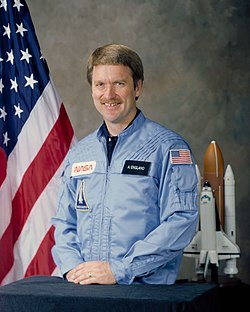Career
England was selected as a scientist-astronaut by NASA in August 1967, as part of the 6th astronaut selection. [4] At 25 years 81 days old, he was the youngest candidate to be selected up to that time. [5] [6] He subsequently completed the initial academic training and a 53-week course in flight training at Laughlin Air Force Base, Texas. He received his wings with distinguished honors in April 1969. [7] England served as a support crewman for the Apollo 13 and 16 flights. He was also an EVA CapCom during the Apollo 16 mission, talking to astronauts John Young and Charlie Duke while they explored the surface of the Moon. [8] Notably, he developed and communicated instructions for construction of the lithium hydroxide canisters on Apollo 13. [9]
England and Philip Chapman resigned from NASA in 1972, citing the era's decline in crewed missions and severe dearth of flight opportunities. Neither had flown in space at that point. England remained with the federal government at the United States Geological Survey, where he served as deputy chief of the Office of Geochemistry and Geophysics. [10] He also served as associate editor for the Journal of Geophysical Research . He served on the National Academy's Space Studies Board, and on several federal committees concerned with Antarctic policy, nuclear waste containment, and federal science and technology. [3]
England returned to the Johnson Space Center in 1979 as a senior scientist-astronaut (mission specialist), was assigned to the operation mission development group of the Astronaut Office, and eventually managed that group. [3]
Space Shuttle flight
STS-51-F, carrying a seven-man crew and Spacelab-2, was launched from Kennedy Space Center, Florida on July 29, 1985. This mission was the first pallet-only Spacelab mission and the first mission to operate the Spacelab Instrument Pointing System (IPS). It carried 13 major experiments of which seven were in the field of astronomy and solar physics, three were for studies of the Earth's ionosphere, two were life science experiments, and 1 studied the properties of superfluid helium. England was responsible for activating and operating the Spacelab systems, operating the IPS and the Remote Manipulator System, assisting with experiment operations, and performing a contingency EVA had one been necessary. After 126 orbits of the Earth, STS 51-F Challenger landed at Edwards Air Force Base, California, on August 6, 1985. [3]
From May 1986 to May 1987, England served as a program scientist for Space Station Freedom (which later evolved into the International Space Station). From June 1987 to December 1987, he taught Remote Sensing Geophysics at Rice University. England retired from NASA in 1988. [3]
Personal
England was married for 51 years to his childhood sweetheart, Kathi (Kreutz) until her death in 2013 and has two daughters: Heidi and Heather. He has five grandchildren: Brandi, Spenser, Charlene, Brock, Sage.. [14] His recreational interests include sailing and amateur radio. [3]
England's career is chronicled in the book NASA's Scientist-Astronauts by David Shayler and Colin Burgess. [11]
